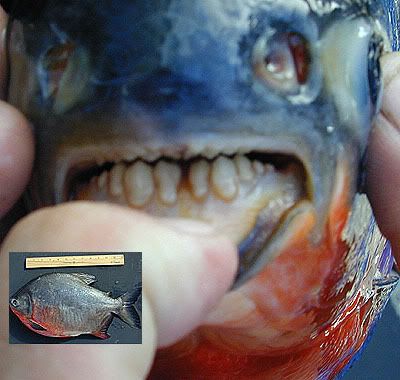From the San Jose Mercury News:
Andre Roberts was hoping to reel in a whopper while fishing at a suburban Hercules park Tuesday, but no one was expecting what the 11-year-old landed on the end of his hook.
"He goes over and pulls in this big old fish," said Tania Esquivel of El Sobrante, who was fishing at Refugio Valley Park. "It had a stub-nose chin, it had a stub-nose face, and it had a red belly, and we said, `Dang! It looks like a piranha!' "
The proud fisherman put his squirming 2-pound catch in a plastic bucket and fed it some raw fish, which it snapped up immediately, Esquivel said.
But authorities say no one should worry that the lake at Refugio Valley Park is teeming with carnivores from the Amazon; the fish has tentatively been identified as a pacu, a largely vegetarian species from South America that closely resembles its more famous cousin.
The 13-inch pacu was likely dumped in the park by a pet owner who did not realize how quickly it would grow, piranha expert Frank Magallanes said. Some types of pacus can grow up to 5 feet long and are legal in California.
The fish is now dead and waiting for state Fish and Game officers to pick it up so animal researchers can study it, Contra Costa County Animal Services Lt. Joe DeCosta said.
This summer, Contra Costa animal control officers caught two alligators, which were most likely dumped by their owners. Over the years, DeCosta said, his department has caught a pair of escaped African lions, an elephant, a Burmese python, gila monsters and injured otters.
"And I don't even want to talk about the whale anymore," DeCosta said with a laugh, referring to a pair of humpback whales that got lost in the Delta during the spring. "You name it, I think we get it."
Every year Magallanes hears of at least two or three cases of someone catching a pacu in a North American lake or river and mistaking it for a piranha. One federal study shows pacus have been caught in nearly every state. By comparison, piranhas have been caught in nine or 10 states, Magallanes said.
In California, three pacus are known to have been caught in the wild in the past 20 years - one in the San Joaquin River in Fresno in 1987, one at the Stevens Creek Reservoir in Santa Clara County in 1996 and one at Adobe Creek in Petaluma in 2000, according to the U.S. Geological Survey.
Pacus can survive in freshwater as cold as 47 degrees, Magallanes said. Piranhas are more delicate, and require warmer water.
When they are young, pacus are omnivores and have been seen scavenging alongside piranhas, Magallanes said. When pacus get bigger, they will eat nuts and seeds that fall into the water.
The chief physical difference between a piranha and a pacu is the fish's jaw - piranhas have razor-sharp teeth that extend out of their mouth like an overbite while pacus have two rows of sharp teeth up top and a row of grinding teeth, much like human teeth, below.
The lake at Refugio Valley Park is mostly filled with catfish, bluegill and trout, said Esquivel, who regularly fishes at popular spots in the county with her son, Jared. She and Jared returned to the park Wednesday with their fishing poles.
"To make a long story short, we're trying to catch piranhas out here," Esquivel said. "I brought some raw hamburger meat and we're putting it out on hooks."



No comments:
Post a Comment